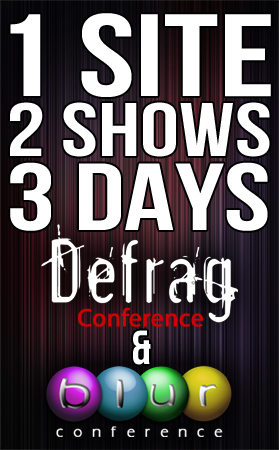One of the first blogs I read this morning was Paul Gillin’s reflections on CMP laying off 20% of its workforce, and shuttering or consolidating a bunch of print mags. The whole move is, of course, indicative of much larger changes in “media.” And it is not just happening at CMP, as IDG stopped printing Infoworld earlier this year as well. (sidenote: If you haven’t read Paul’s new book, “The New Influencers,” I highly recommend it.)
The truth of the matter is that while print ad revenue is declining steadily, events and online (in “tech media” in general) are doing well. In case you haven’t noticed, there are somewhere around 500 gajillion tech conferences out there right now. The reason is simple: events are doing well.
Which is very different from events being *done well*….
I always hesitate to write about this stuff because I’m “in the game” (in more ways than one), but this morning (for some reason), I’m feeling like a little public reflecting. So let me set aside print (which I know *nothing* about) and online (which I know quite a bit about), and talk exclusively about tech events (which I think I now know too much about ![]() .
.
One of the interesting things for someone like me is that I can start conferences (like Defrag) that “conference companies” would have a difficult time starting. The reason is simple: An “early” show just doesn’t make that much money (if any), and when you have a “team” (marketing, ops, PR, sales, logistics) working an event, it is hard to make the economics wash. On the other hand, take a look at Defrag: I have a some great “outside helpers” that fill gaps in my knowledge (for free and out of the goodness of their hearts), but in general - its me doing sales, marketing, pr, etc. That alone makes it easy for me to run what could be called an “early” show in the beginning — where I can make it work, where a “conference company” would be (most likely) losing money.
The other side of the “one man team” approach is that bureaucracy drops to zero. I *am* the decision point on sales, marketing, etc - so it becomes very easy (ie, I don’t have to run something “up the chain” to get approval). Now, I know the conference producers out there will respond with “yes, but don’t you have trouble fulfilling all of the details” — well sure, my 60 days leading up to Defrag are pure chaos, but hey, that’s half of the fun of it all. Bottom line: until you reach a point of scale, 1-2 people really can “do it all.” (This is not to say you don’t have to know what you’re doing; I’ve had the great fortune of learning *how* from some great people.)
How does all of this relate to “new media,” you ask? Because the “early conference” can fill niches, be focused, and attack really early vectors that the “bigger guys” can’t or won’t go after (at first). Its the whole “niche marketing” angle. While conference producers are always looking for the “next big show,” I’m looking to help an emergent community come together. By the way, that’s not to say that conference producers are evil people (all of the ones I know are *great* people), rather its just a matter of economics: if you’re a conference producer you WANT a comdex or web 2.0 expo because that’s where the economics of scale *really* kick in.
From my point of view, the key to it all is hidden in that last paragraph: I *love* to focus on helping an emergent community figure itself out. And that takes time (it took 5 years with Digital ID World).
So, how does that focus change my focus? Ahh, this is where it gets good.
It is very easy when you run a conference to fall into a trap: the idea that the vendors are your customers. That’s an easy trap because the vendors appear to be the ones writing you checks — so they must be your customer, right? Not really.
(note: I can’t take full credit for the following idea, as it is something that Phil Becker and I developed while working on Digital ID World.)
Think of it this way: the “event” business is a spectrum. On the left side of the spectrum are “conferences” (or summits), and at the right side of the spectrum are “expos” (or trade shows). The purest conference makes *all* of its money on attendees, and *no* money on vendors. PC Forum is the perfect example of this — and it is AMAZINGLY hard to actually pull off (its why Esther did such an incredible thing). PC Forum charged its attendees, and had *no* “sponsors”. At the expo side, the great majority of money is made from vendors. Think the RSA Security show, or any large expo. You sell booths to vendors and charge minimal amounts of money to attendees (if at all). These are, obviously, two *radically* different businesses.
As you move from left to right on the spectrum (from PC Forum toward expo), you encounter “hybrids” — shows like Defrag, where the revenue is split between vendors and attendees (the perfect “hybird” is a 50/50 split). Here’s where the confusion occurs…
At a “conference,” it really is all about content, people and networking. At an expo, it really is all about “walking the floor” to see cool stuff. The customer of a conference is the *attendee*. The customer of an expo is the vendor. In a hybird, you’re working with both attendees and vendors — and the mistake is to think that (if you’re trying to scale) the vendor is your customer. They’re not.
Vendors sponsor conferences to gain “access” to attendees. Without attendees, conferences are just vendor-fests. Ergo, *attendees* are the true “customer” of the conference. They may not always be the biggest revenue generator, but they are the engine that makes the conference business run. And trust me, remembering that as you build out a conference ain’t easy. Especially if you’re running a team of 12 people, where 90% of those people are focused on vendor fullfillment (sales, logistics, etc).
That, my friends, is why so many tech conferences fall short of expectations — they take their eye off the ball; thinking they’re just trying to keep vendors happy. Now, I’m not saying that I ignore vendors — quite the contrary, I *love* our sponsors and could never pull this off without them (thank you guys!). But if a choice comes down to best for the attendee vs. best for the vendor — you choose the attendee. Period. Vendors may not understand that in the short term (they think they’re your customer as well), but they’ll come to love it in the long term. Focusing on attendees is the only way to help build a self-sustaining community — and once the community is self-sustaining, you’re in the sweet-spot; the conference succeeds.
As I write this, I feel like the perception may be that I’m trashing other conferences and I don’t want that to be the case. There are some *fabulous* conferences out there (Supernova and Gnomedex come to mind), shows run by people (like Kevin Werbach and Chris Pirillo) who *know* what their focus needs to be. I guess all I’m really saying is that when you get the bureacracy of a “business” running, it gets very easy to get distracted.
Now, throw some “online” and “print” into that mix — where the focus is on ad selling — and the pull of distraction gets even stronger.
When I first talked with Phil about Defrag, he said very pointedly: “just know that you’re ready to kill yourself for the next 3-5 years.” The basis of that statement comes from the fact that building community takes a lot of long-range, hard work. But that focus is the only way that you build a successful conference.
And you need some magic to happen along the way.
I’m hoping that magic happens with Defrag (it feels like it is), and I’ll hope you’ll help me discover that.
In the meantime, watch the “tech conference” business. The economy is good right now, so there will be more conferences than there are attendees, and “conference fatigue” will become a very real thing. Surviving the “good times” is really about getting the right focus. Only then can you run a show in a down economy (when all of the other shows go away), and know that you’ve created REAL value.
Alright, enough reflecting — back to getting on focus.

